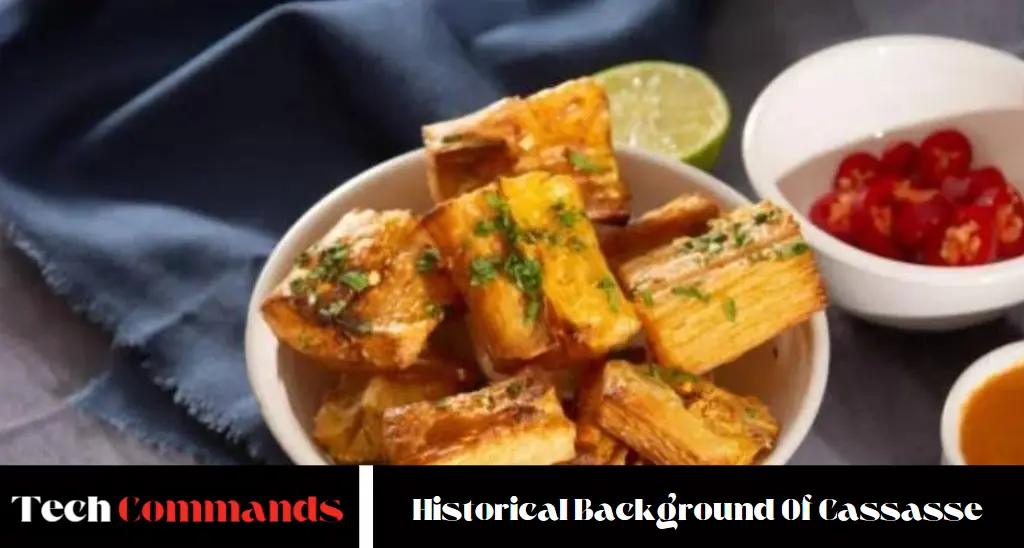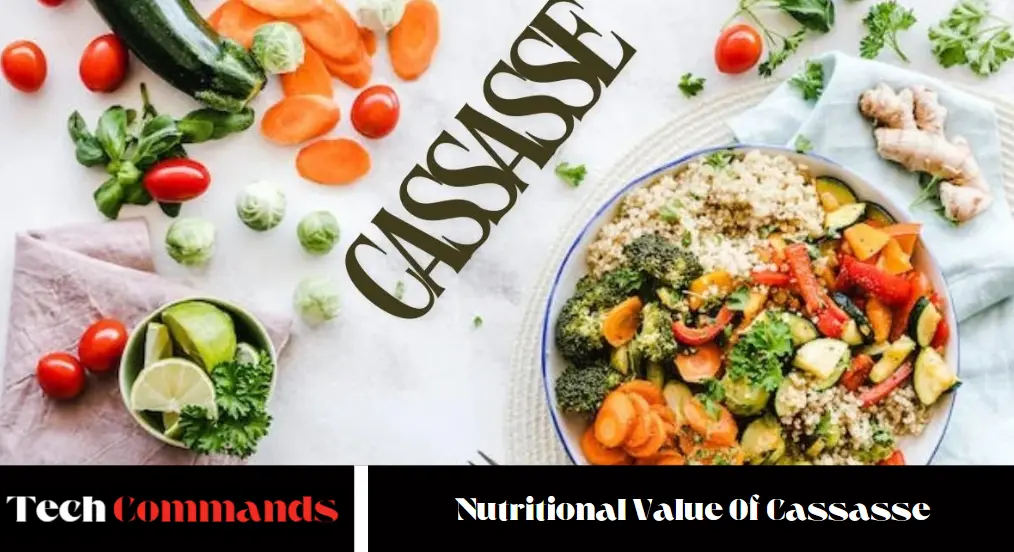It seems Cassasse remains unclear in its context or definition. If it’s a term or concept from a specific domain or region, precise information would be necessary to provide a meaningful introduction. Any attempt to define or describe it could be inaccurate without further details. If you can provide additional context or specify where “Cassasse” is used, I can help craft a suitable introduction.
Historical Background Of Cassasse

The origins of Cassasse can be traced back to the indigenous peoples of the Caribbean, who first embraced the local ingredients that would define this dish. The name “Cassasse” is thought to have roots in these early communities, though its precise etymology remains debated among historians.
Indigenous Arawak and Carib tribes played a pivotal role in cultivating and utilizing root vegetables, herbs, and spices abundant in their surroundings, forming the foundational flavors of Cassasse.
The culinary landscape evolved with the arrival of Europeans and the transatlantic slave trade. African slaves brought new cooking techniques and ingredients that merged with existing traditions. European colonizers also introduced additional elements, creating a distinct fusion that characterizes Cassasse today.
Ingredients Of Cassasse
The ingredients of Cassasse typically include a blend of indigenous, European, and African influences, reflecting the historical culinary fusion of the Caribbean region. While specific recipes can vary, common ingredients often found in Cassasse include:
- Root Vegetables: Such as cassava (yuca), sweet potatoes, yams, or taro.
- Herbs and Spices: Including cilantro, thyme, garlic, and hot peppers, which add depth and heat to the dish.
- Protein: Traditionally, this might include fish, such as saltfish (salted cod), or other seafood like shrimp.
- Coconut Milk: Used to create a creamy base that binds the ingredients together and adds richness.
- Seasonings: Salt, black pepper, and sometimes additional spices like paprika or allspice.
- Onions and Peppers: Often sautéed to provide a savory and aromatic base.
These ingredients are typically combined and cooked to create a hearty and flavorful dish that reflects the diverse cultural influences of the Caribbean. Recipe variations may occur based on regional preferences and available ingredients.
Traditional Preparation Methods
Cooking Techniques:
Cassasse is traditionally cooked using slow methods to enhance the blending of flavors. This often involves simmering over a wood fire, imparting a distinctive smokiness that enriches the dish.
Tools and Utensils:
Traditional tools like large iron pots and wooden stirring paddles play a crucial role in the preparation of cassasse. These heirloom utensils, passed down through generations, hold cultural significance and contribute to the authentic preparation of the dish.
Community Involvement:
In Caribbean communities, preparing Cassasse is often a communal affair. Families and neighbors gather to cook large batches, especially during festivals and gatherings, fostering social solid connections and preserving cultural traditions.
Cassasse Recipes
Certainly! Here’s a basic recipe for Cassasse, a traditional Caribbean dish that combines Indigenous, European, and African influences:
Ingredients:
- 1 lb saltfish (salted cod), soaked and shredded
- 2 cups cassava (yuca), peeled and grated
- 1 cup sweet potatoes, peeled and grated
- 1 onion, finely chopped
- 2 cloves garlic, minced
- 1 hot pepper (Scotch bonnet or habanero), finely chopped (adjust to taste)
- 1 cup coconut milk
- 1/4 cup fresh cilantro, chopped
- 2 tbsp fresh thyme leaves
- Salt and black pepper to taste
- Cooking oil for sautéing
Instructions:
Prepare the Saltfish:
- Rinse the saltfish thoroughly under cold water to remove excess salt. Soak it in water for at least 1 hour (or overnight, changing the water a few times) to reduce saltiness. Shred the saltfish into small pieces.
Prepare the Vegetables:
- Peel and grate the cassava and sweet potatoes. Squeeze out any excess liquid from the grated cassava.
Sauté the Aromatics:
- Heat a bit of cooking oil over medium heat in a large pot or deep skillet. Sauté the chopped onion, minced garlic, and hot pepper until fragrant, about 2-3 minutes.
Add the Grated Vegetables:
- Add the grated cassava and sweet potatoes to the pot. Stir well to combine with the aromatics.
Cook the Mixture:
- Pour in the coconut milk and stir the mixture thoroughly. Let it simmer over medium-low heat for about 15-20 minutes, stirring occasionally, until the vegetables are tender and the mixture has thickened.
Incorporate the Saltfish:
- Add the shredded saltfish to the pot. Mix it into the vegetable mixture and continue simulating for 10-15 minutes, allowing the flavors to meld together. Adjust seasoning with salt and black pepper as needed.
Finish and Serve:
- Stir in the chopped cilantro and thyme leaves. Remove from heat and let the Cassasse rest for a few minutes before serving.
Serve Warm:
- Cassasse is traditionally served warm as a main dish. It can be enjoyed independently or with sides like fried plantains, breadfruit, or rice.
This recipe offers Caribbean culinary tradition’s savory and hearty taste, blending diverse flavors into a comforting dish. Adjust spice levels and ingredients to suit your taste preferences for a personalized Cassasse experience.
Read More: 10desires.org with Empowering Health and Wellness Great
Cassasse In Daily Life
Role in Everyday Meals:
Cassasse isn’t just enjoyed on special occasions; it’s a staple in many Caribbean households. Its hearty ingredients make it ideal for any mealtime, offering both sustenance and comfort.
Celebratory and Festive Occasions:
During holidays and festivals, Cassasse holds a special place. It’s often prepared in generous portions and shared among family and friends, symbolizing unity and celebration.
Symbolism and Cultural Significance:
Beyond its culinary appeal, Cassasse embodies cultural identity and heritage. Cooking and sharing this dish is a meaningful way for Caribbean communities to honor their traditions and connect across generations.
Nutritional Value Of Cassasse

Cassasse, a traditional Caribbean dish, offers a variety of nutritional benefits due to its wholesome ingredients. While specific dietary values can vary based on preparation methods and ingredient proportions, here’s a general overview of the dietary components typically found in Cassasse:
- Proteins: Cassasse often includes protein-rich ingredients like saltfish (salted cod) or other seafood, providing essential amino acids for muscle function and overall health.
- Carbohydrates: Root vegetables such as cassava (yuca) and sweet potatoes are primary sources of carbohydrates in Cassasse. These carbohydrates provide energy essential for daily activities.
- Fiber: Root vegetables also contain dietary fiber, which promotes healthy digestion and helps maintain a feeling of fullness.
- Vitamins and Minerals: Cassasse includes various vitamins and minerals from ingredients like sweet potatoes (vitamin A, vitamin C, potassium) and herbs/spices (vitamin K, calcium, iron).
- Healthy Fats: Coconut milk, a common ingredient, contains healthy fats that can support heart health and provide sustained energy.
- Moderation of Sodium: Depending on preparation methods and saltfish usage, Cassasse may contain moderate sodium levels. Managing salt intake is vital for overall cardiovascular health.
Cassasse provides a balanced mix of nutrients, making it a nutritious choice when prepared with fresh ingredients and in moderation. Adjusting ingredients and portion sizes can further tailor its nutritional profile to individual dietary needs and preferences.
Cassasse Across The Caribbean.
Cassasse, a dish deeply rooted in Caribbean culinary tradition, varies in preparation and ingredients across the region’s diverse islands. Here’s a glimpse into how Cassasse is enjoyed across different parts of the Caribbean:
- Jamaica: Known as “Bammie and Fish,” a variation of Cassasse involves cassava bread (bammie) served with fried or steamed fish, often accompanied by spicy sauces and vegetables.
- Trinidad and Tobago: Cassasse may include ingredients like okra and pumpkin, adding a unique texture and flavor to the dish. It’s often served alongside traditional sides such as rice and peas.
- Dominica: Cassasse is a staple dish prepared with grated cassava and coconut milk. It’s often paired with fish or other seafood and enjoyed both in everyday meals and during festive occasions.
- Grenada: Like Dominica, Grenadian Cassasse features cassava and coconut milk as crucial ingredients. It’s a hearty dish often served at family gatherings and cultural celebrations.
- Haiti: Known as “Akasan,” Cassasse takes on a porridge-like form in Haiti, made from cornmeal or corn flour cooked with water and served sweetened or flavored with spices like cinnamon.
- Barbados: Cassasse here may include cornmeal as a base and cassava, creating a rich and filling dish often enjoyed with fried fish or chicken.
Throughout the Caribbean, Cassasse serves as a nourishing meal and reflects the cultural diversity and historical influences that shape each island’s culinary heritage. Variations in ingredients and preparation methods highlight the region’s vibrant culinary traditions and the dish’s adaptability to local tastes and ingredients.
The Future Of Cassasse
Looking ahead, Cassasse appears poised to continue evolving while maintaining its deep cultural roots in the Caribbean. Here are some potential aspects that could shape its future:
- Health Consciousness: As global dietary trends lean towards healthier options, there may be adaptations of Cassasse recipes to incorporate more nutritious ingredients or cooking methods, such as using leaner proteins or reducing saturated fats.
- Innovation and Fusion: With increased culinary experimentation and fusion cuisine trends, Cassasse could inspire new interpretations, blending Caribbean flavors with global influences and appealing to a broader audience.
- Sustainability: There might be a growing emphasis on sustainable sourcing of ingredients used in Cassasse, promoting local agriculture and seafood practices that support environmental stewardship.
- Cultural Preservation: Efforts to preserve and promote Caribbean cultural heritage could lead to initiatives documenting traditional Cassasse recipes, techniques, and stories, ensuring they are passed down to future generations.
- Global Awareness: Increased tourism and interest in Caribbean cuisine globally could lead to greater awareness and appreciation of Cassasse outside the region, potentially influencing culinary trends worldwide.
Through these potential pathways, Cassasse could continue to be a beloved dish within Caribbean communities and gain recognition as a symbol of the region’s rich cultural and culinary diversity on the global stage.
Advantages of Cassasse
The advantages of Cassasse, a traditional Caribbean dish, stem from its wholesome ingredients and cultural significance:
- Nutritional Benefits: Cassasse typically includes nutritious ingredients such as root vegetables (like cassava and sweet potatoes), which are rich in vitamins, minerals, and dietary fiber. These contribute to a balanced diet and promote overall health.
- Protein-Rich: Often prepared with saltfish or other seafood, Cassasse provides a good source of lean protein essential for muscle growth and repair.
- Cultural Heritage: Enjoying Cassasse connects individuals to Caribbean cultural roots, preserving traditions and fostering community and identity.
- Versatility: Cassasse can be adapted with various ingredients and cooking methods, making it versatile for different tastes and dietary preferences.
- Social Bonding: Preparing and sharing it during gatherings and celebrations strengthens familial and communal ties, enhancing social cohesion.
- Flavor and Satisfaction: Known for its robust flavors, Cassasse offers a satisfying eating experience celebrating Caribbean culinary diversity.
Cassasse offers nutritional advantages and cultural and social benefits, making it a cherished part of Caribbean heritage and cuisine.
Frequently Asked Questions
What is Cassasse?
Cassasse is a traditional Caribbean dish. It typically consists of grated root vegetables (such as cassava and sweet potatoes) combined with seafood (often saltfish) or other proteins and cooked in coconut milk with herbs and spices.
Where does Cassasse originate from?
Cassasse has its roots in the culinary traditions of indigenous peoples of the Caribbean, evolving over centuries with influences from African and European cultures through colonization and trade.
How is Cassasse prepared?
Cassasse is usually prepared by grating and mixing root vegetables, cooking them with coconut milk, and adding saltfish or other proteins. It’s often slow-cooked to allow flavors to meld, traditionally over a wood fire for added smokiness.
What are the main ingredients in Cassasse?
The main ingredients typically include cassava (yuca), sweet potatoes, coconut milk, saltfish (salted cod), onions, garlic, hot peppers, and herbs and spices like thyme and cilantro.
Is Cassasse spicy?
Cassasse can be spicy depending on the amount of hot peppers used. Spiciness levels can be adjusted to suit individual preferences.
When is Cassasse traditionally served?
Cassasse is enjoyed year-round and is not limited to special occasions. It’s commonly served as a main dish for lunch or dinner in Caribbean households and is also popular during festivals and gatherings.
Can Cassasse be made vegetarian or vegan?
Cassasse can be adapted for vegetarian or vegan diets by omitting saltfish and using plant-based alternatives or additional vegetables for protein and flavor.
What are some variations of Cassasse?
Variations of Cassasse exist across different Caribbean islands. For example, some versions may include additional ingredients like okra, pumpkin, or cornmeal, reflecting local preferences and availability of ingredients.
Conclusion
Cassasses is a culinary gem of the Caribbean, embodying a tapestry of history, culture, and tradition. From its origins among indigenous peoples to its contemporary interpretations, Cassasses has maintained its status as a cherished dish that unites communities. Its enduring appeal underscores both its delightful flavors and profound cultural significance.
As we gaze forward, safeguarding and honoring Cassasses will uphold this esteemed legacy within Caribbean cuisine. By preserving its heritage and celebrating its diversity, we ensure that Cassasses continues to flourish and resonate with future generations. This commitment sustains a beloved culinary tradition and reinforces its role as a cultural ambassador of the Caribbean on the global stage.

